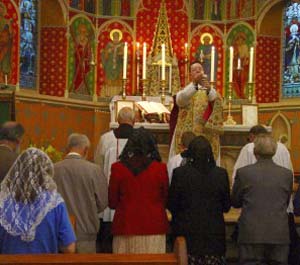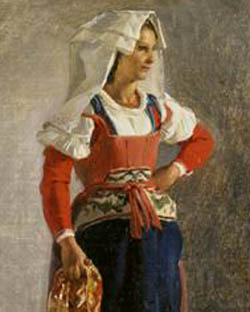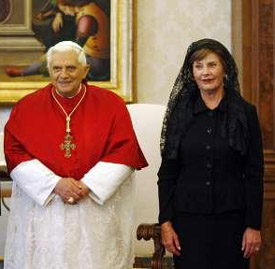5.1 The Ideal Situation
What, then, are the practical implications of this historical study of the veil in the Christian tradition? Can this ancient and admirable tradition, so adamantly insisted upon by the Fathers and Doctors of the Church, have any relevance in this thoroughly pagan age?

Women should always cover their heads in Catholic churches |
The ideal implication of this doctrine, of course, is the full restoration of the veil among all Catholic families. The importance which the great minds of the Church have attached to the veil throughout History strongly invites us to restore such customs. All women should have a covering on their heads at Mass and other religious ceremonies in the sacred building; otherwise, we are being unfaithful to the Christian tradition, and also unfaithful to the Apostle, who first commanded it.
Would it be necessary for a woman to cover her head all the time? Based on the studies we presented before, this would seem normal in a Christian Civilization, but, alas, these times have passed. Progressivism has gained control of the Church and convinced Catholics to adapt themselves to the Modern World. This is, in fact, what they did. Unfortunately we live in days where only Muslim women still wear veils all the time. So, until we are in conditions where this situation might change, what would seem appropriated for Catholic women to do? I will distinguish between the ideal and the feasible.

A 19th-century Roman peasant in traditional dress and head covering |
Ideally speaking, for women it would not seem to be necessary to follow the custom of the veil in its patristic rigor. While some Fathers who spoke on the topic seem to advise always keeping the hair covered when in public, their justification for this can be differentiated from the justifications of both the Apostle and the medieval thinkers. While the fact of a woman having something over her hair is always justified by the divine analogy of Christ to the Church and God to man, the fact of a woman having her hair tightly bound was justified as a prevention of lustful behavior. These rationales are clearly different, and therefore require a different approach.
In the realm of principles, the divine analogy remains valid: the symbolism that represents it must be maintained. This is the explicit command of St. Paul in the Scriptures, and therefore of God Himself, as well as the primary intention of the Fathers and the Doctors of the Church. So the requirement of women having something on their heads, at least in the ideal world of a rebuilt and united Christendom, should not be abrogated.
The justification of prevention of lust may not, however, be so stringent. These proscriptions of the Fathers may well have been due to the constraints of time and place rather than the universal truths of God and man, as the Apostle’s law is. Perhaps this looseness of the hair had been adopted as a sign of the pagan resistance to the Christian moral law; perhaps there was simply a great cultural sensitivity to women’s hair in the patristic age. Whether or not this strict rule must be applied, then, depends upon the examination of the conditions of our own time, taking always the wisdom of the Church as our guide.
5.2 A Practical Solution
What part of this ideal may be put into practice in our days?
We do not live, in a rebuilt and united Christendom. In fact, we live in a degraded and dead, or nearly dead, Christendom, which is showing no immediate signs of revival. As the world descends back into pagan chaos, how can this Christian doctrine of the veil be implemented in the daily lives of the faithful remnant?

A Spanish lady wears a mantilla during Holy Week 2007 |
To begin with, there can be no real reason for a failure to implement this custom at least within the confines of a church. In church, at least, the great truths of the Faith are still recognized by some, and the symbolism of the veil will be neither lost nor misinterpreted as an attempt to be holier-than-thou – except, perhaps, by those of bad will, who resent anyone who attempts a greater conformity to Catholic tradition than they themselves. Furthermore, wearing the veil within a church is within even a clear and uninformed reading of the Veil Text, as we saw in a previous article (Section 2.2). The wearing of the veil in such contexts is, therefore, even according to those who might disagree with the tradition outlined in this series, simply an exercise in obedience to Holy Writ, and can be opposed by no one of good will.
The further extension of the Catholic veil should, from this stage, be natural and organic. As familiarity with the custom becomes better known, Catholics may come to know the whole tradition and begin following the custom even outside of sacred buildings. Even should Catholics fail to do so, the natural desire of any sincere Christian to bring the beautiful symbolism of the liturgy into daily life will result in many women choosing to extend the custom of the veil or other head covering on their own volition. In this way the full beauty of the Christian tradition of the veil will be restored among the faithful, assisting thereby in the evangelization of the world.

According to Vatican protocol, Queens or First Ladies who visit the Pope should dress in black and cover their heads with a veil
|
For can we truly expect converts if we prove ourselves to be part of the world? Who would become Catholic if Catholics are of the world? Who would become Catholic if being a Catholic entailed no real change from what one already is? Will these customs expose us to ridicule and hatred? Certainly, but so does our Faith itself. Converts are more attracted to a Faith which demands something of its adherents. Otherwise, conversion is not truly conversion; it is merely a changing of name.
The veil is an authentic and beautiful part of the Catholic tradition, proclaiming numerous and lofty aspects of our holy religion and providing a noble and obvious sign of contradiction to the world that so hates the message which our God has brought forth for us. The very existence of the natural hierarchy, the acknowledgement that God is above man, has vanished from our culture; everywhere the assertion that all men are equal triumphs.
The veil shows our opposition to the world and to the libertine ethos which modernity has made triumphant. The dominating forces of Feminism, Pantheism, Hedonism, and Egalitarianism all receive a standing rebuke from the simple fact of a Catholic woman putting a covering upon her blessed and noble head. The veil is a beautiful and worthwhile custom; it ought to be preserved where it exists and restored where it does not, and thence extended to its full and proper practice throughout the entire Catholic world.

Posted April 23, 2008
Go to Introduction Part 1 Part 2 Part 3 Part 4 Part 5 Part 6
The pleasure TIA has to publish collaborations of our guest columnists does not imply that it endorses all the opinions expressed in their articles.
Return to TOP

Related Topics of Interest
 Restoration: Let's Begin with the Veil Restoration: Let's Begin with the Veil
 St. Pius X on Priestly Dignity and Propriety St. Pius X on Priestly Dignity and Propriety
 Titles and Signs of Respect for Priests and Religious Titles and Signs of Respect for Priests and Religious
 Getting the Ball Rolling on Hats Getting the Ball Rolling on Hats
 Why Shouldn't Women Wear Trousers Today? Why Shouldn't Women Wear Trousers Today?

|